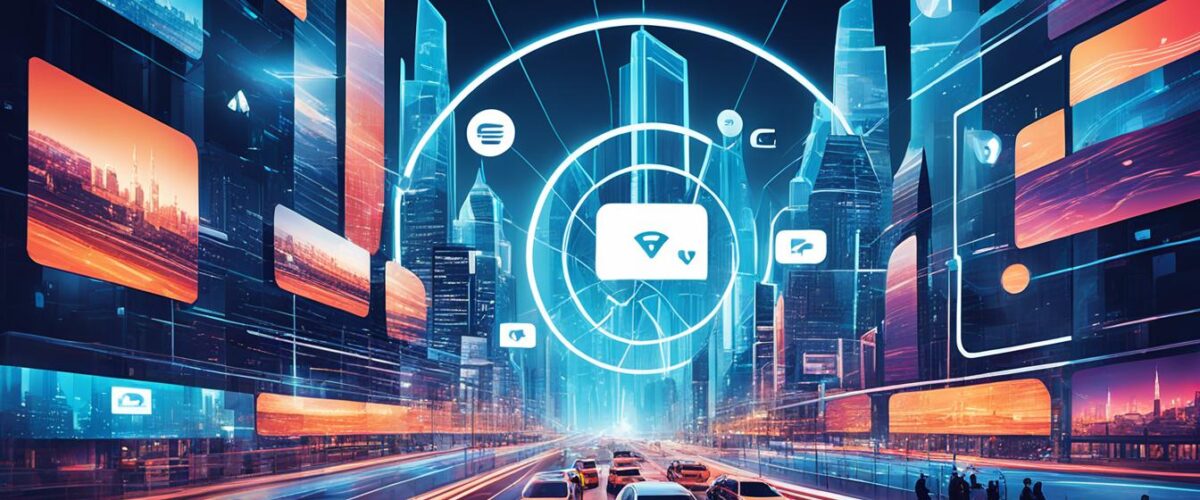Did you know that by 2050, approximately 68% of the world’s population is projected to live in urban areas?
This rapid urbanization calls for innovative solutions to enhance urban infrastructure and improve the quality of life for residents. One such solution is the integration of Internet Protocol Television (IPTV) in smart cities, which offers seamless urban connectivity and an enhanced entertainment experience.
Key Takeaways:
- IPTV is a digital television service delivered over the internet, providing a wide range of channels and on-demand content.
- Smart cities require reliable and efficient connectivity to support the implementation of various IoT applications and services.
- By utilizing IPTV in smart cities, residents can access a diverse range of entertainment options, enhancing their quality of life.
- The future of IPTV in smart cities holds promising trends, including personalized content, interactive features, and immersive technologies.
- IPTV in smart cities plays a significant role in enhancing urban connectivity and entertainment options.
Understanding Smart Cities and Their Importance in Urbanization
As urbanization continues to accelerate, the concept of smart cities has become increasingly vital in ensuring sustainable quality of life for the growing urban population. With India’s urban population projected to experience significant growth in the coming years, the development of smart cities is crucial for accommodating this expansion and supporting economic growth.
Smart cities are not mere urban areas; they are carefully planned and developed with a focus on integrating Information and Communication Technology (ICT) to create a connected and efficient urban environment. The goal is to provide swift mobility, reliable infrastructure, access to social services, and sustainable resource management.
Investment in smart cities’ infrastructure is essential for creating a suitable environment for future residents. This includes integrating smart technology into transportation systems, utility networks, and communication channels, among others. By leveraging ICT, smart cities can optimize resource allocation, improve public safety, and enhance the overall quality of urban life.
The Impact of Smart Cities on Urban Life
The implementation of smart cities can significantly improve the quality of life for urban residents in various ways. First, enhanced connectivity and efficient infrastructure can reduce commute times, alleviate traffic congestion, and enhance overall mobility. This, in turn, leads to greater convenience and productivity for residents and boosts economic activity, ultimately contributing to GDP growth.
Furthermore, smart cities prioritize sustainable resource management and environmental preservation. By leveraging data-driven insights, these cities can optimize energy usage, manage waste efficiently, and minimize environmental impact. As a result, smart cities contribute to a more sustainable and eco-friendly urban landscape.
Access to social services, such as healthcare facilities and educational institutions, is also a priority in smart city development. By integrating smart technology, cities can improve service delivery, streamline administrative processes, and ensure equitable access to essential services. This fosters social inclusion and empowers residents to lead healthier, more fulfilled lives.
In summary, smart cities represent a significant step forward in urbanization. By leveraging ICT and embracing sustainable practices, these cities enhance connectivity, improve infrastructure, and create a higher quality of life for urban residents. The following table provides an overview of the key benefits and features of smart cities:
| Benefits of Smart Cities | Key Features of Smart Cities |
|---|---|
| – Improved urban connectivity | – Integrated ICT infrastructure |
| – Enhanced productivity and economic growth | – Efficient transportation systems |
| – Sustainable resource management | – Optimized utility networks |
| – Equitable access to social services | – Smart governance and administration |
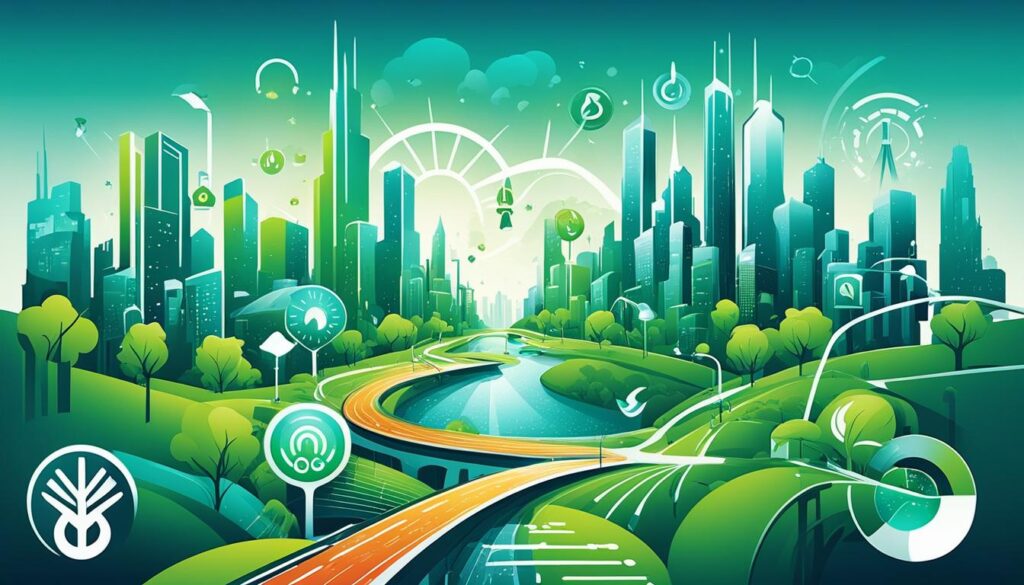
As smart city initiatives gain momentum worldwide, it is imperative to recognize the potential for urbanization to thrive sustainably. Through the integration of ICT, smart cities can transform the urban landscape, improving the lives of millions and fostering a more connected and prosperous future.
Characteristics of Smart Cities
Smart cities possess several distinguishing characteristics that set them apart from traditional cities. These features align with the goal of creating more sustainable, efficient, and livable urban environments. Let’s explore some key elements that define smart cities:
- Integrated Transport: Smart cities prioritize a well-connected transport system that enables efficient mobility. Integrated transport networks, including public transportation options, smart traffic management systems, and the promotion of alternative modes of transportation, contribute to reduced congestion and improved accessibility.
- Utilities Coverage: A hallmark of smart cities is the aim to achieve comprehensive utilities coverage. This encompasses a 100% provision of essential services, such as waste management, drainage, telecommunication, electricity, and water supply. The goal is to ensure reliable and accessible utilities for all residents.
- ICT Integration: Information and Communication Technology (ICT) integration is paramount in smart cities. By incorporating ICT into transportation systems and utilities, real-time monitoring, data analysis, and management become possible. Connected infrastructure enhances efficiency, enables predictive maintenance, and improves the overall quality of urban services.
- Energy Efficiency: Smart cities prioritize energy efficiency and the reduction of carbon emissions. Embracing renewable energy sources, implementing energy-saving technologies, and promoting sustainable practices contribute to lower energy consumption and a greener environment.
- Sustainable Buildings: Architecture and construction practices in smart cities prioritize sustainability. Building designs focus on energy efficiency, the use of eco-friendly materials, and integrated technologies that maximize resource utilization. Sustainable buildings are essential for reducing the environmental impact of urban development.
- Access to Jobs and Services: Smart cities recognize the importance of providing equitable access to job opportunities, education, healthcare services, and other essential amenities. Enhancing accessibility ensures that residents can actively participate in the economic and social aspects of city life.
To illustrate the interconnectedness of these characteristics, let’s visualize them in a table:
| Characteristics of Smart Cities |
|---|
| Integrated Transport |
| Utilities Coverage |
| ICT Integration |
| Energy Efficiency |
| Sustainable Buildings |
| Access to Jobs and Services |
By embodying these characteristics, smart cities create an urban environment that is not only technologically advanced but also sustainable, inclusive, and conducive to a high quality of life.
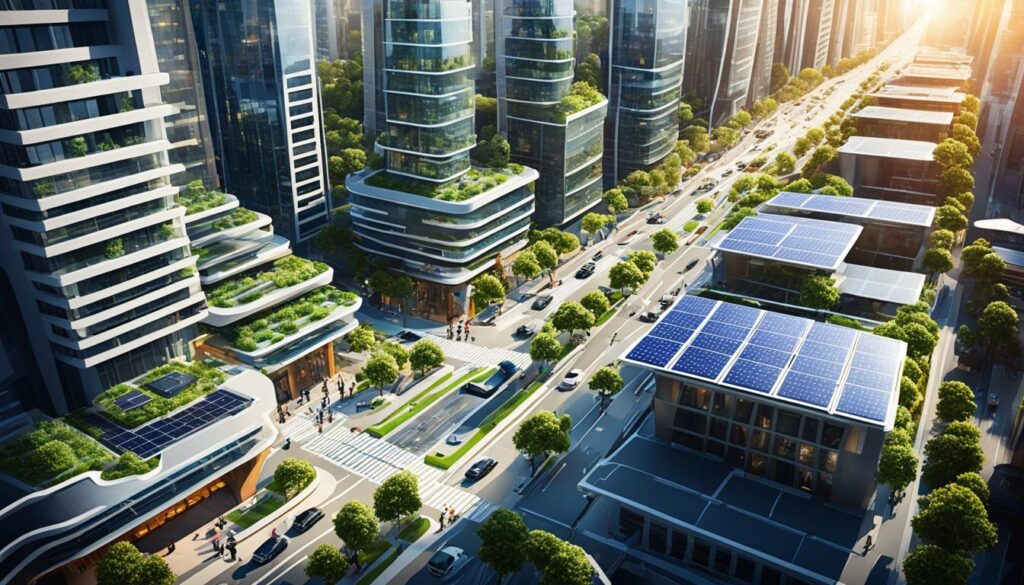
Types of Smart Cities
Smart cities come in different forms and can be categorized based on their level of ICT integration and purpose. Each type of smart city has its own unique characteristics and requirements. Let’s explore the different types of smart cities:
1. New Cities
New cities are purposefully designed and built from scratch with integrated ICT infrastructure. These cities aim to attract residents and businesses by offering advanced technology and modern amenities. The development of new cities provides an opportunity to incorporate smart technologies seamlessly into the urban fabric, enabling efficient services, sustainable infrastructure, and an enhanced quality of life.
2. Retrofitting Existing Cities
Retrofitting involves upgrading and gradually integrating smart technologies into the existing infrastructure of established cities. This process allows cities to leverage their existing resources and gradually transform into smart cities. Retrofitting may involve the installation of sensors, smart grids, and other ICT systems to enhance energy efficiency, transportation, and other essential services. By retrofitting existing cities, urban areas can adapt to the changing needs of residents while minimizing disruption and maximizing cost-effectiveness.
3. Purpose-Driven Cities
Purpose-driven cities are designed and developed around specific industries or activities. These cities focus on fostering innovation, research, or specialized industries to drive economic growth and attract talent. Examples of purpose-driven cities include science towns, technology hubs, or innovation clusters. These cities integrate ICT infrastructure and services tailored to the specific needs of their specialized industries, nurturing collaboration, and enabling cutting-edge advancements.
4. ICT Integration in Various Sectors
A key characteristic of smart cities is the integration of ICT in various sectors to create a comprehensive and interconnected ecosystem. Smart cities incorporate ICT integration in areas such as:
- Environment: Utilizing sensors and data analytics to monitor and manage environmental factors, including air quality, waste management, and climate control.
- Energy: Implementing smart grids, energy-efficient systems, and renewable energy sources to optimize energy consumption and reduce environmental impact.
- Transportation: Developing intelligent transportation systems, including smart traffic management, public transportation optimization, and electric vehicle infrastructure.
- Buildings: Creating smart buildings with energy-efficient systems, automated controls, and advanced connectivity to enhance comfort, security, and sustainability.
- Governance: Using ICT systems for efficient administration, citizen engagement, and data-driven decision-making processes.
- Social Infrastructure: Implementing ICT solutions to improve access to healthcare, education, public safety, and other essential services for residents.
By integrating ICT in these sectors, smart cities can enhance efficiency, sustainability, and the overall quality of life for their residents.
Table: Comparison of Different Types of Smart Cities
| Type of Smart City | Main Characteristics | Key Focus Areas |
|---|---|---|
| New Cities | Built from scratch with integrated ICT infrastructure | Attracting residents and businesses, seamless technology integration |
| Retrofitting Existing Cities | Gradually integrating smart technologies into existing infrastructure | Upgrading existing urban areas, minimal disruption |
| Purpose-Driven Cities | Designed around specific industries or activities | Specialized industries, innovation, research |
Source: Own Creation
In conclusion, smart cities come in different types, each with its own approach to ICT integration and purpose. Whether building new cities, retrofitting existing ones, or creating purpose-driven urban areas, the goal is to leverage technology to create sustainable, connected, and future-ready environments.
Challenges in Setting up Smart Cities
Setting up smart cities presents a myriad of challenges that need careful consideration and planning. These challenges encompass various aspects of infrastructure, funding, regulations, and management. Addressing these challenges is crucial to ensure the successful implementation and operation of smart cities.
Power Infrastructure
A key challenge in setting up smart cities is establishing reliable and efficient power infrastructure. Smart cities demand robust energy sources to support their advanced technological systems. This involves optimizing power generation, distribution, and consumption to cater to the diverse needs of the city’s residents and industries.
Funding
Funding plays a critical role in the development and implementation of smart city projects. The transformation of a city into a smart city requires significant investment in infrastructure, technology, and services. Collaborative efforts between public and private sectors, as well as innovative financing mechanisms, are necessary to secure the funds needed for smart city initiatives.
Regulatory Challenges
Smart cities bring forth regulatory challenges in managing the sharing economy and ensuring fair regulation of public goods and services. With the emergence of digital platforms and the sharing economy, regulations need to be adapted to accommodate new business models while safeguarding public interests. This includes creating frameworks for data privacy, cybersecurity, and equitable access to shared resources.
Infrastructure Financing
Infrastructure financing is a crucial aspect of smart city development. The scale and complexity of building smart city infrastructure require substantial capital investment. Exploring public-private partnerships, innovative financial instruments, and international collaborations can help secure the necessary funding for infrastructure projects in smart cities.
Management of Smart Cities
The efficient management of smart cities is vital to ensure smooth operation and delivery of services. Smart cities rely on integrated systems, real-time data, and advanced analytics to optimize resource allocation, enhance service delivery, and improve overall quality of life. Effective governance models, skilled workforce, and transparent management practices are essential in the successful operation of smart cities.
Overcoming these challenges requires collaboration between government bodies, private sector stakeholders, and regulatory authorities. Together, they can navigate the complexities of power infrastructure, funding, regulatory frameworks, and management to create sustainable and vibrant smart cities that enhance the lives of their residents.
The Role of Internet of Things (IoT) in Smart Cities
In the development and implementation of smart cities, the Internet of Things (IoT) plays a crucial role. IoT enables seamless connectivity between various devices, facilitating the exchange of real-time data for monitoring and management. Through the deployment of smart devices and sensors across the city, valuable data is gathered to optimize operations and improve efficiency.
Automation and smart systems, driven by IoT technology, contribute to the sustainability and resource efficiency of cities. By integrating different systems and services within a smart city ecosystem, IoT enables a seamless flow of information and actions. The immense amount of data collected from IoT devices informs decision-making processes, leading to enhanced overall functioning of smart cities.
The widespread adoption of IoT in smart cities leads to improved connectivity, increased automation, and enhanced urban living experiences. The integration of IoT empowers smart cities to harness the power of connectivity, maximize the potential of data, and leverage smart devices and sensors to drive efficiency and innovation.
Benefits of IoT in Smart Cities
- Connectivity: IoT enables seamless connectivity between devices, systems, and services, fostering a highly interconnected smart city ecosystem.
- Data Insights: The data collected from IoT devices provides valuable insights for decision-making processes and enhances the efficiency of city operations.
- Smart Devices and Sensors: Deploying smart devices and sensors across the city allows for real-time monitoring, ensuring optimal performance and resource management.
- Automation and Efficiency: IoT-powered automation streamlines processes, increases efficiency, and reduces resource consumption, making smart cities more sustainable.
With the integration of IoT, smart cities can unlock their full potential, leveraging connectivity, data, and automation to create efficient, innovative, and livable urban environments.
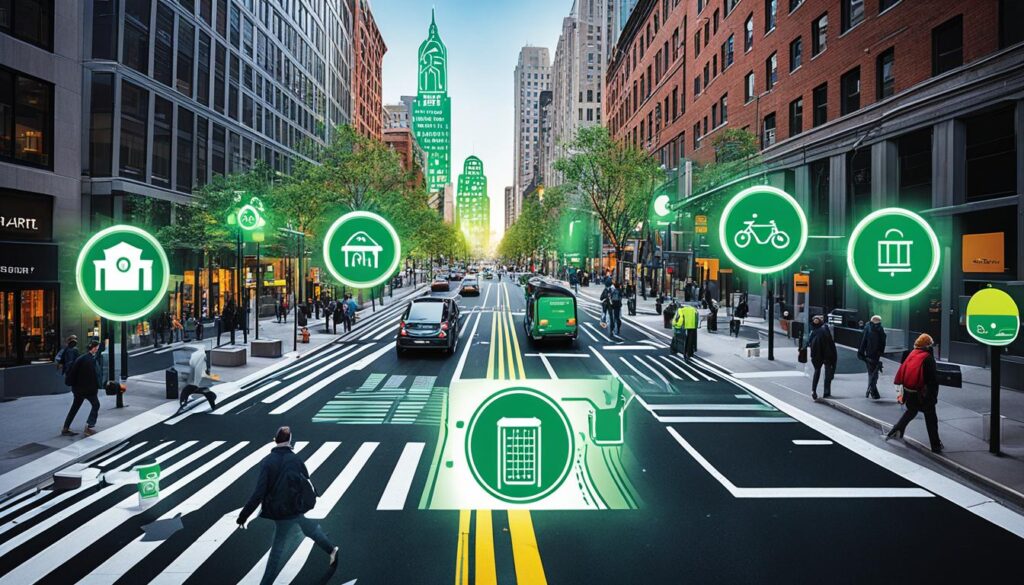
| Benefits of IoT in Smart Cities | Key Aspects |
|---|---|
| Connectivity | Seamless connection between devices, systems, and services |
| Data Insights | Valuable data for informed decision-making and efficient city operations |
| Smart Devices and Sensors | Real-time monitoring for optimized performance and resource management |
| Automation and Efficiency | Streamlined processes, increased efficiency, and reduced resource consumption |
Enhancing Entertainment in Smart Cities with IPTV
When it comes to entertainment in smart cities, IPTV subscription services offer residents a diverse range of channels and content to satisfy their entertainment needs. With IPTV, users can access an extensive library of movies, TV shows, and live events, ensuring there is something for everyone.
One of the key advantages of IPTV is its seamless streaming capability, allowing for high-quality content delivery without interruptions. Whether residents are binge-watching their favorite TV shows or enjoying a movie night, they can count on uninterrupted and smooth streaming.
IPTV services in smart cities provide a convenient and user-friendly experience. Residents can subscribe to these services and enjoy a vast selection of on-demand content, giving them the freedom to watch what they want, when they want. The entertainment possibilities are endless with IPTV.
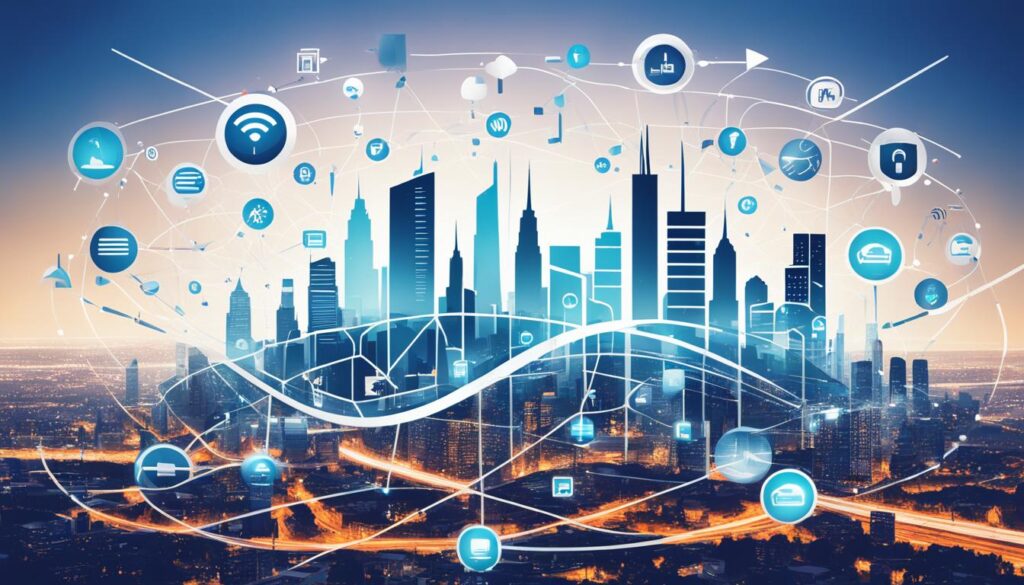
With the immersive entertainment solution offered by IPTV, smart city residents can personalize their entertainment experience. They can access their favorite shows and movies anytime, anywhere. Whether it’s catching up on the latest episode of a beloved series or streaming a blockbuster movie, IPTV provides a seamless and enjoyable entertainment experience.
Benefits of IPTV in Smart Cities:
- Access to a diverse range of channels and content
- Seamless streaming for uninterrupted entertainment
- A vast library of on-demand content
- Personalized entertainment experience
IPTV subscription services play a crucial role in enhancing the overall entertainment experience for residents in smart cities. With its diverse range of channels, seamless streaming capabilities, and on-demand content, IPTV provides an immersive entertainment solution that aligns perfectly with the vision of smart cities.
| Benefits of IPTV in Smart Cities |
|---|
| Access to a diverse range of channels and content |
| Seamless streaming for uninterrupted entertainment |
| A vast library of on-demand content |
| Personalized entertainment experience |
Smart Cities and Urban Connectivity
Urban connectivity is a vital component of smart cities as it enables seamless communication and access to services. To achieve this, smart cities require robust internet infrastructure to support high-speed broadband connectivity. The deployment of 5G technology further enhances connectivity by enabling faster data transfer.
In addition, Wi-Fi networks play a crucial role in providing urban connectivity within smart cities, allowing residents to access the internet on the go. This ubiquitous access to Wi-Fi networks ensures that residents can stay connected, access online services, and utilize the benefits of living in a smart city.
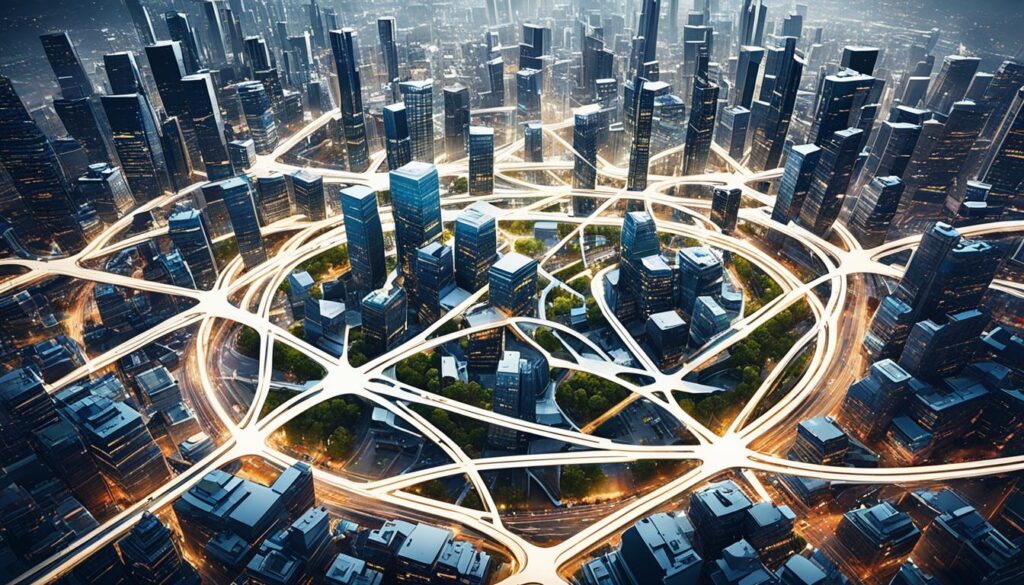
Advantages of Urban Connectivity in Smart Cities
The presence of strong internet infrastructure, broadband connectivity, 5G technology, and Wi-Fi networks offers several advantages:
- Seamless Communication: Urban connectivity enables residents to communicate seamlessly through various digital channels, including social media, messaging apps, and Voice over Internet Protocol (VoIP) services.
- Access to Services: Robust connectivity allows residents to access essential services such as e-government portals, online healthcare systems, and education platforms from the comfort of their homes.
- Smart Transportation: Connectivity enables the implementation of smart transportation systems, including real-time traffic monitoring, intelligent traffic lights, and navigation apps, improving mobility within the city.
- IoT Applications: Reliable connectivity supports the integration of numerous IoT applications, such as smart energy meters, environmental sensors, and waste management systems, enhancing resource management and sustainability.
Planning and Expanding Urban Connectivity
Smart city planners prioritize the development of reliable and widespread connectivity to support the growing number of IoT applications and services. They work closely with internet service providers (ISPs) and telecommunication companies to ensure the availability of high-speed internet infrastructure and coverage.
Furthermore, city planners aim to create a comprehensive network of Wi-Fi hotspots throughout the city to provide residents with convenient access to the internet. These Wi-Fi networks complement existing broadband services, creating a seamless and expansive connectivity ecosystem.
Case Study: The Role of 5G Technology in Urban Connectivity
The deployment of 5G technology revolutionizes urban connectivity by enabling faster data transfer, low latency, and enhanced network capacity. This technology promises to unlock the full potential of smart cities by supporting bandwidth-intensive applications, such as augmented reality (AR), virtual reality (VR), and autonomous vehicles.
With the introduction of 5G, smart cities can take advantage of improved network performance and offer innovative services to their residents. Whether it’s real-time video streaming, immersive virtual experiences, or seamless connectivity among IoT devices, 5G technology drives urban connectivity to new heights.
The Future of IPTV in Smart Cities
IPTV technology in smart cities is continuously evolving, with exciting future trends on the horizon. These developments promise to enhance the entertainment experience for residents and provide seamless streaming of high-quality content. Let’s explore some of the key advancements that we can expect:
1. Personalized Content Recommendations
The future of IPTV will offer more personalized content recommendations tailored to individual preferences and viewing habits. Advanced algorithms and data analysis will enable IPTV platforms to curate content that aligns with users’ interests, ensuring a more engaging and enjoyable entertainment experience.
2. Interactive Features and Interfaces
Interactive features and interfaces will play a significant role in enhancing user engagement with IPTV content. Imagine being able to interact with your favorite TV shows or movies, creating a more immersive and interactive entertainment experience. These features will foster a sense of active participation, making the content more dynamic and captivating.
3. Integration of Virtual Reality and Augmented Reality
The integration of virtual reality (VR) and augmented reality (AR) technologies with IPTV will revolutionize the way we consume entertainment in smart cities. Residents will be able to immerse themselves in virtual worlds, enhancing their viewing experience and creating a new level of engagement with the content. Whether it’s watching a live sports event or exploring a virtual museum, the possibilities will be endless.
4. Seamless Multi-Device and Multi-Platform Streaming
In the future, IPTV will focus on delivering seamless streaming across multiple devices and platforms. Residents will have the flexibility to enjoy their favorite content on smartphones, tablets, smart TVs, and other internet-enabled devices. This multi-device compatibility will provide unparalleled convenience and accessibility, ensuring that entertainment is always at their fingertips.
5. Advanced Analytics and Data-Driven Insights
Data-driven insights and advanced analytics will play a vital role in improving the content curation and delivery process. IPTV platforms will leverage user data to gain valuable insights into viewing habits, preferences, and trends. This information will enable providers to fine-tune their content offerings, ensuring that residents receive the most relevant and engaging entertainment options.
As the future of IPTV unfolds, smart cities can look forward to an enhanced entertainment experience. With personalized content recommendations, interactive features, virtual reality integration, seamless streaming, and data-driven insights, the possibilities for entertainment in smart cities are limitless.
Conclusion
Smart cities and IPTV are integral to creating seamless urban connectivity and enhancing the entertainment experience for residents. IPTV subscription services in smart cities offer a diverse range of channels and content, catering to residents’ entertainment needs. The development and deployment of smart city infrastructure rely on robust internet connectivity and the integration of IPTV technology.
Looking ahead, the future of IPTV in smart cities holds promising trends. Personalized content recommendations, interactive features, and immersive technologies such as virtual reality and augmented reality will further enhance the entertainment experience. IPTV will continue to play a significant role in shaping the urban connectivity landscape and providing residents with high-quality, seamless streaming experiences.
As smart cities continue to evolve, the integration of IPTV technology will be crucial for meeting the growing demands of urban connectivity and entertainment options. By leveraging the power of IPTV, smart cities can provide their residents with an array of entertainment choices while ensuring seamless streaming experiences. With the convergence of smart city initiatives and IPTV, urban connectivity and the entertainment landscape will continue to thrive and reshape the future of cities worldwide.
FAQ
What is IPTV?
What are smart cities?
How does IPTV enhance the entertainment experience in smart cities?
How important is urban connectivity in smart cities?
What is the role of IoT in smart cities?
What are the challenges in setting up smart cities?
How does IPTV contribute to the future of smart cities?
Why are smart cities important in urbanization?
What are the characteristics of smart cities?
What are the types of smart cities?
